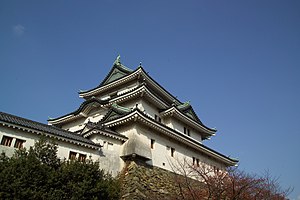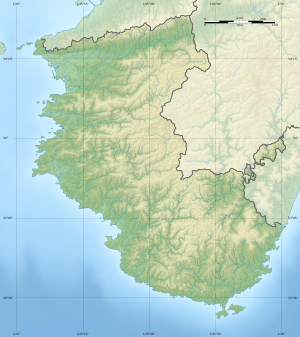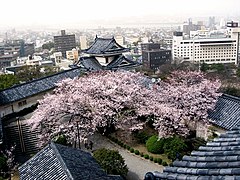Wakayama Castle
| Wakayama Castle | ||
|---|---|---|
|
View of the castle tower |
||
| Alternative name (s): | Takegaki-jō, Torafusu-jō | |
| Creation time : | End of the 16th century | |
| Castle type : | Hirayamajiro (hill castle) | |
| Conservation status: | Receive | |
| Place: | Wakayama | |
| Geographical location | 34 ° 13 '39.5 " N , 135 ° 10' 17.8" E | |
| Height: | 49 m TP | |
|
|
||
The Wakayama Castle ( Japanese 和 歌 山城 or rarely 若 山城 , Wakayama-jō ), also called Takegaki-jō ( 竹 垣 城 ), Torafusu-jō ( 虎伏 城 ), is located in the city of Wakayama . The castle was the seat of the Kishu-Tokugawa , one of the three Tokugawa branch families .
history
The castle, built on the orders of Toyotomi Hideyoshi as a further focus next to Osaka Castle, came to Asano Yoshinaga after the Battle of Sekigahara . The castle, in a safe location on the "Stretching Tiger" Mountain ( 虎伏 山 , Torafusu-yama ) rises above the nearby Kinokawa River . The Asano expanded the castle, but in 1619 the 10th son of Tokugawa Ieyasu , Yorinobu (1602–1671), was enfeoffed with it. The received, from the castle Mito coming, with 18 years a huge feud with an income of 555,000 Koku . He had enough funds to expand the castle between 1621 and 1629 so large that the shogunate disliked it.
The attachment
The castle tower, which originated from the Asano period, burned down in 1846, but was rebuilt in 1850, and it was more complex. In addition to the large tower, there was now also a smaller tower, which was supplemented by stretched structures, Tamonyagura ( 多 門 櫓 ), placed on walls . The large castle tower, it resembled the castle tower before the fire, was designated as a national treasure, but was lost in 1945 in bombing raids during World War II. It was reconstructed in 1958 as a reinforced concrete structure and can be visited.
If you climb up to the castle, you can recognize the stone walls from Hideyoshi's time by their moderate carving ( 野 面積 石 垣 , nozurazumi ishigaki ), which differ from the later, more precise carving ( 切 込 ハ ギ 石 垣 , kirikomi hagi ishigaki ) from the middle Edo -Time is different.
The Okaguchi Gate, together with the preserved moat in front of it, has been recognized as an important cultural asset . The remains of the castle are also registered on a national level as a “historical site”, the garden ( 紅葉 渓 庭園 , Momijidani teien ) in Nishi-no-maru is registered as a “beautiful view”. The large old camphor trees in the castle area are registered as natural monuments at the prefecture level.
photos
literature
- Hashiba, Akira: Wakayama-jo in: Miura, Masayuki (ed.): Shiro to jinya . Saikoku-hen. Gakken, 2006. ISBN 978-4-05-604379-2 .
- Zenkoku jōkaku kanri kyōkai (ed.): Shiro no shiori [bookmarks of the castles]. 1986.






